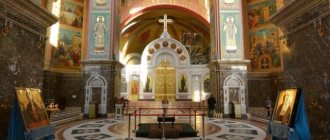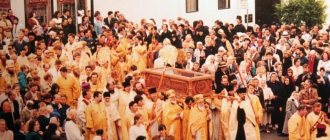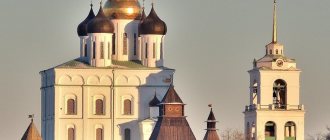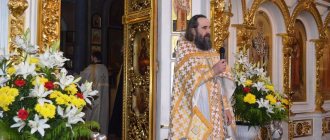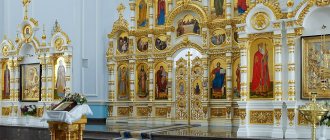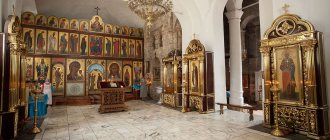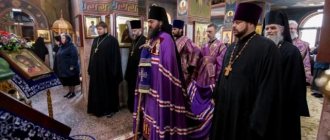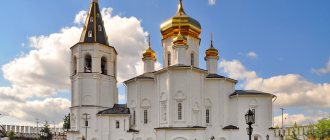Mir
Russia Krasnodar region Krasnodar St. Catherine's Cathedral (Krasnodar) Map is loading…
{"format":"leaflet","minzoom":false,"maxzoom":false,"limit":50,"offset":0,"link":"all","sort":[""], "order":[],"headers":"show","mainlabel":"","intro":"","outro":"","searchlabel":"\u2026 \u0441\u043b\u0435\ u0434\u0443\u044e\u0449\u0438\u0435 \u0440\u0435\u0437\u0443\u043b\u044c\u0442\u0430\u0442\u044b","default":"","import-annotation":false,"width ":"auto","height":"350px","centre":{"text":"","title":"""link":"""lat":45.0205729999999988422132446430623531341552734375,"lon": 38.97455599999999975580067257396876811981201171875,"icon":""},"title":"","label":"","icon":"","lines":[],"polygons":[],"circles":[ ],"rectangles":[],"copycoords":false,"static":false,"zoom":8,"defzoom":14,"layers":["OpenStreetMap"],"image layers":[] ,"overlays":[],"resizable":false,"fullscreen":true,"scrollwheelzoom":true,"cluster":false,"clustermaxzoom":9,"clusterzoomonclick":true,"clustermaxradius":80, "clusterspiderfy":true,"geojson":"","clicktarget":"","showtitle":true,"hidenamespace":false,"template":"","userparam":"","activeicon": "","pagelabel":false,"ajaxcoordproperty":"","ajaxquery":"","locations":[{"text":"\u003Cb\u003E\u003Ca href=\"/palomnik/%D0% A1%D0%B2%D1%8F%D1%82%D0%BE-%D0%95%D0%BA%D0%B0%D1%82%D0%B5%D1%80%D0%B8%D0%BD %D0%B8%D0%BD%D1%81%D0%BA%D0%B8%D0%B9_%D0%BA%D0%B0%D1%84%D0%B5%D0%B4%D1%80%D0 %B0%D0%BB%D1%8C%D0%BD%D1%8B%D0%B9_%D1%81%D0%BE%D0%B1%D0%BE%D1%80_(%D0%9A%D1% 80%D0%B0%D1%81%D0%BD%D0%BE%D0%B4%D0%B0%D1%80)\» title=\»\u0421\u0432\u044f\u0442\u043e-\u0415\ u043a\u0430\u0442\u0435\u0440\u0438\u043d\u0438\u043d\u0441\u043a\u0438\u0439 \u043a\u0430\u0444\u0435\u0434\u0440\u0430\u04 3b\u044c\u043d\u044b\u0439\ u0441\u043e\u0431\u043e\u0440 (\u041a\u0440\u0430\u0441\u043d\u043e\u0434\u0430\u0440)\»\u003E\u0421\u0432\u044f\u0442\u043e- \u0415\u043a\u0430 \u0442\u0435\u0440\u0438\u043d\u0438\u043d\u0441\u043a\u0438\u0439 \u043a\u0430\u0444\u0435\u0434\u0440\u0430\u043b\u044c\u 043d\u044b\u0439\u0441\u043e \u0431\u043e\u0440 (\u041a\u0440\u0430\u0441\u043d\u043e\u0434\u0430\u0440)\u003C/a\u003E\u003C/b\u003E\u003Chr /\u003E\u003Ca h ref=\"/ palomnik/%D0%A1%D0%B2%D0%BE%D0%B9%D1%81%D1%82%D0%B2%D0%BE:%D0%90%D0%BD%D0%BD%D0% BE%D1%82%D0%B0%D1%86%D0%B8%D1%8F\" title=\"\u0421\u0432\u043e\u0439\u0441\u0442\u0432\u043e:\u0410\u043d\u043d \u043e\u0442\u0430\u0446\u0438\u044f\»\u003E\u0410\u043d\u043d\u043e\u0442\u0430\u0446\u0438\u044f\u003C/a\u003E: \u043a\u0 430\u0444\u0435\ u0434\u0440\u0430\u043b\u044c\u043d\u044b\u0439 \u0441\u043e\u0431\u043e\u0440 \u0415\u043a\u0430\u0442\u0435\u0440\u0438\u0 43d\u043e\u0434\u0430\u0440\ u0441\u043a\u043e\u0439 \u0438 \u041a\u0443\u0431\u0430\u043d\u0441\u043a\u043e\u0439 \u0435\u043f\u0430\u0440\u0445\u0438\u 0438","title":"\u0421 \u0432\u044f\u0442\u043e-\u0415\u043a\u0430\u0442\u0435\u0440\u0438\u043d\u0438\u043d\u0441\u043a\u0438\u0439 \u043a\u0430\ u0444\u0435\u0434\u0440\ u0430\u043b\u044c\u043d\u044b\u0439 \u0441\u043e\u0431\u043e\u0440 (\u041a\u0440\u0430\u0441\u043d\u043e\u0434\u0430\u0440)",» link":"", "lat":45.0205729999999988422132446430623531341552734375,"lon":38.97455599999999975580067257396876811981201171875,"icon":""}],"imageLay ers":[]}
45.020551; 38.974819
Russia, Krasnodar, Central District, Central microdistrict, Kommunarov street, 52
Krasnodar, Krasnodar region
Russia
Telephone:
+7 (861) 267-33-64
Email:
St. Catherine's Cathedral
— Cathedral of the Ekaterinodar and Kuban diocese.
History[[edit]h2>
The decree on the construction of the cathedral was issued on October 17, 1889 - exactly one year after the tragedy of the crash of the royal train of Alexander III. Shortly before the crash, Emperor Alexander III and his wife and sons visited Ekaterinodar. In honor of the deliverance of the royal family from death, it was decided to build a majestic cathedral with seven thrones in Yekaterinodar. It was supposed to dedicate the main Throne to the Holy Great Martyr Catherine, and name the rest in honor of the heavenly patrons of the members of the August Family: Mary, Nicholas, George, Michael, Xenia and Olga.
The temple was founded on April 23, 1900 on Catherine Square, where by that time the already dilapidated wooden church of St. Catherine, erected in 1814. Local architect Ivan Klementievich Malgerb worked on the project. The construction of the cathedral was often suspended due to lack of funds. Finally, on March 24, 1914, with the active participation of the mayor of Yekaterinodar, Mikhail Skvorikov, the construction of the cathedral was completed and the solemn consecration of the main altar took place.
During the Civil War, prominent participants in the White movement were buried in the tomb of the Catherine Cathedral: General Alekseev, Colonel Mionchinsky, Lieutenant General Timanovsky.
In 1922 the cathedral became Renovationist. In the same year, under the guise of helping the starving, the Volga region was completely plundered. In the 1930s, the cathedral was prepared for explosion for the sake of bricks. Architect Ivan Malgerbu managed to convince the commission for the destruction of churches that its destruction was inappropriate.
On June 26, 1934, the renovationist diocesan administration announced that the community had disintegrated due to its small numbers. The cathedral was turned into a warehouse. The bells were removed for melting down.
The resumption of worship took place in 1942 during the occupation of Krasnodar by Nazi troops, but at the same time there were also warehouses here. The cathedral resumed its full activity in 1944, after the liberation of Krasnodar from the Nazi invaders. But the names of the limits were changed to Uspensky, Voskresensky, Blagoveshchensky, Sergievsky, Varvarinsky. The main one of the limits retained its former name - Ekaterininsky.
Architecture and interior decoration
St. Catherine's Church in Krasnodar was built in the Russian-Byzantine style, has five squat domes - a large one in the center and four smaller ones in the corners. The drums are surrounded by a window arcade. For the anniversary of the cathedral in 2012, craftsmen from Moscow and Rostov covered the main dome with gold leaf and installed a new cross.
The external walls are laid out using decorative relief masonry: arched edges above the windows, a patterned cornice and ornamental belts along the perimeter, and crosses protruding from the walls in some places. The bell tower is connected to the main room and serves as the entrance. In front of the entrance there is a porch - a porch, the steps to the door symbolically narrow, reminding all those entering the words of the Gospel: “Enter through the narrow gate...”
The interior decoration is impressive. The walls were painted by famous icon painters. Painting of the chapel of St. Varvara (below) has been preserved since 1917 - this is the work of the artist Ivan Sidorovich Izhakevich, who belonged to the partnership of artists of religious painting in Kyiv.
For the celebration of the 1000th anniversary of the Baptism of Rus', wall painting in the Assumption chapel was resumed, and the iconostasis in St. George's was updated. For the 100th anniversary of the cathedral, the chapels of Sergius of Radonezh and Annunciation were restored, and a new iconostasis was installed in the central Catherine.
Temple shrines
After its resumption in Krasnodar, the Catherine Cathedral is replenished with shrines. First of all, this is a shrine with the relics of the new martyr Alexander of Fleginsky, the patron saint of Kuban, glorified in 2022. There are also pieces of relics here:
- St. VMC. Catherine;
- VMC. Barbarians;
- Saint James.
Particularly revered icons of the Mother of God are “Kazan” and “Iverskaya”. The first is decorated with jewelry, which the parishioners left as a token of gratitude for the help received, requested in prayers to the Mother of God. The pre-revolutionary image of “All Saints”, removed during the atheistic times, also returned.
In May 2022, an icon of John the Russian was brought here from the Greek island of Euboea. This island is known in the Orthodox world for the fact that the incorruptible relics of the mentioned saint are located there. And the image that arrived in Krasnodar was painted there. Now those who wish can pray in front of the face.
Modern life
Today this is a place where religious services are held daily, active social activities take place: there is an Orthodox community of sisters of mercy, family and youth centers, a charitable foundation and a department for prison ministry, a pilgrimage complex, and a library have been opened.
An icon painting studio operates under the leadership of Sofia Anatolyevna Machigina. Children and adults attend Sunday school (theological courses). It is especially crowded here on holidays. Metropolitan Isidore, priests of other parishes, guests and pilgrims from other cities of the Krasnodar Territory come here to perform divine services.
Abbots, clerics
- Alexander Purlevsky (early 1921 - December 16, 1922)
- Victor (Oleynik) (1968 - 1978)
- Valentin Mertsev (December 1, 1982 - February 16, 1984) acting
…
- Leonid (Gorbachev) (1995 - 1997)
- Tikhon (Lobkovsky) (January 2004 - April 2005)
Cathedral interior
The interior of the temple amazes visitors with its beauty. The walls are covered with paintings, on which famous masters worked. One of them is Ivan Sidorovich Izhakevich
, outstanding Russian artist. In 1917, he created a painting in the lower aisle of St. Barbarians. The images have survived to this day.
Interior of the cathedral
The painting combines elements of Byzantine and Kyiv style. There are a large number of ornaments that frame the faces of saints. The main iconostasis is made of marble, and its decoration is decorated with gilding. The fences and canopy are also gilded.
This temple is a unique historical and architectural monument. He plays a special role in the spiritual life of Kuban, he is loved and appreciated by the residents of Krasnodar.
Address and schedule of services
- Address: Kommunarov street, 52, Krasnodar, Russia.
- GPS coordinates: 45.020611, 38.974642.
- Phone: +7-861-262-56-36.
- Official website: https://www.kubansobor.ru/
- Opening hours: from 7:00 to 20:00.
- Schedule of services: https://www.kubansobor.ru/lists/raspisanie-bogoslujeniy/
Indeed, St. Catherine's Cathedral in Krasnodar is amazing. Visitors leave positive reviews about it as a blessed place. Here you can pray, relax your soul, take a photo against the backdrop of the majestic temple, get some holy water, and even buy aromatic pastries from the temple confectionery. Come and see for yourself! In the meantime, we offer a short video review of the Orthodox site, enjoy watching!
Life of the temple in times of democratic change
In 1988, when the whole country celebrated the millennium of the baptism of Rus', St. Catherine's Cathedral (Krasnodar) was restored, and the bell rang out from its belfry for the first time in many years. It was fully restored to its original appearance in 2011 - the domes of the temple again shone with gold leaf. Statistics show that these days the most visited in the entire Kuban region is St. Catherine’s Cathedral.
Krasnodar has long had deep traditions of spiritual life, and that is why its residents treat this monument of temple architecture with such love. Today, when you come to the cathedral, you can venerate the shrines stored in it. This is the miraculous image of the Kazan Mother of God, and particles of the relics of the great martyrs Catherine, and Barbara, and the holy Apostle James - brother in the flesh of Jesus Christ. It is gratifying to realize that the process of religious revival of the country is becoming more and more noticeable.
Story
Catherine's Cathedral, which is the center of the spiritual life of Krasnodar and its environs. It has an interesting history, full of trials and joyful moments.
St. Catherine's Cathedral in Krasnodar
Consequence of a sad event
In the summer of 1888, the residents of Ekaterinodar were in joyful anticipation of a significant event - the expected arrival of the imperial couple, accompanied by their two sons Nicholas and George. On September 21, the townspeople welcomed the august spouses and the heir to the throne to Catherine Square. After staying three days in the hospitable city, the emperor continued his trip through the southern territories of the state. But at the end of October, the train in which the royals were returning to the capital crashed. As a result, many people died, but with God’s help, all members of the ruling family did not receive serious injuries.
In honor of the miraculous salvation of the ruler, in many cities of the empire, decisions were made to build churches, which were gratitude to the Lord for the salvation of the rulers. Ekaterinodar was no exception, where a year after the sad events they decided to erect a sacred thanksgiving building.
Construction
After the decision was made in 1889 to begin construction of the temple, work began on preparing the project and collecting funds.
- donations from individuals and institutions;
- annual deductions from the city treasury;
- help from wealthy local patrons.
By 1896, project documentation was prepared and a sufficient amount of money was collected to begin work. The city authorities had to decide the issue of the construction site. The choice fell on Catherine Square, where the townspeople met the imperial family. In its center was a small Catherine Church, erected in 1814. The old building needed restoration, and a special city commission decided that this place was ideal for a new church, and the money collected by parishioners for repairs would go to the fund for its construction.
In the spring of 1900, the first stone of the new building was laid. This undertaking was blessed by Archbishop Agafodor of Stavropol and Ekaterinodar.
Historical photo of St. Catherine's Cathedral at the beginning of the twentieth century
Troubled times have come to the empire. Interruptions in the supply of funds and revolutionary events affected the construction timeline. The most important events of this process took place in the following years:
- 1909 - completion of the construction of walls and vaults;
- 1911 - installation of crosses;
- 1912 - completion of exterior decoration;
- 1912-spring 1914 - internal work.
In March 1914, the main altar was consecrated in honor of St. Catherine of Alexandria. The remaining thrones were consecrated in honor of the heavenly patrons of the ruling family.
Test time
The events of 1917 also affected the life of St. Catherine's Cathedral. In 1922, the cathedral passed to the renovationists - part of the clergy who supported the Soviet regime. In the same year, under the pretext of helping the residents of the Volga region, where famine had broken out a year earlier, the authorities confiscated all church valuables.
In 1931, the operation of the church belfry was banned, and most of the bells were melted down. At the same time, he was developing a plan to destroy the temple in order to obtain material for urban construction. The building was saved by its author. Malherbe convinced the authorities that the red brick from the church walls was unsuitable for reuse and that the building was dangerous for the surrounding buildings. Divine services in the saved church ceased in 1934, when renovationists announced the collapse of the parish community.
For 10 years the holy place was used as a warehouse. Changes began in 1942, when the German occupation government allowed the warehouse to be used for prayer. Two years later, the Soviet authorities, who liberated the city, handed over the church to believers and allowed the resumption of services, but on the condition that the minor altars were renamed. There was no place in the Soviet state for the memory of the Russian tsars.
Renaissance
Serious restoration work began in the temple in connection with the approach of the 1000th Baptism of Rus'. This event was marked by the ringing of bells, which for the first time in many years sounded under the arches of the church belfry. The ringing was created by the only miraculously preserved cathedral bell, which was found in the city of Yeisk. By the beginning of the new century, the following work had been carried out in the church:
- the paintings on the walls and vaults were updated;
- the iconostases of the small chapels were repaired;
- purchased new bells for the belfry;
- covered the central dome with gold.
Cathedral iconostasis
In the power of heretics-renovationists
After the October Revolution, the Russian Orthodox Church underwent difficult trials not only as a result of the coming to power of an atheistic government, but also as a result of the internal church schism that arose at that time, called “renovationism.” The adherents of this movement, complete with heresy, declared their unconditional support for the new government and all its transformations.
In response to their loyalty, the schismatics enjoyed a certain amount of patronage from the new authorities. At that time, many temples and monasteries were transferred to their disposal. The Catherine Cathedral (Krasnodar) shared their fate. Since 1922, it was in the hands of renovationists. But no deals with the Antichrist ever ended well - in the same year, patrons, under the guise of helping the hungry, completely plundered the cathedral.
Interesting facts and legends
- 50,000.00 rubles were collected for the construction of the temple;
- To attract additional funds, 45 crypts were built under the cathedral. The tombs were sold to rich people;
- during the low tide of the Great Bell, widows and married women of Ekaterinodar threw their wedding rings into the molten metal;
- merchant I.P. Dobrovolsky built the lower part of the temple with his own money in memory of his late wife, who was buried in one of the cathedral crypts in 1911;
- the construction of the temple cost 300,000.00 rubles;
- gilded crosses were installed on the domes of the newly built cathedral. The largest and heaviest weighed 720 kg;
- the complex was equipped with electric lighting, which was rare in those years;
- the height of the majestic structure is 52 m, total length – 58.4 m, width – 48 m.
- The new temple was popularly called the “Red Cathedral” not only because of the color of the brick, but also because of its extraordinary beauty. After all, this shade in Rus' means “beautiful”.
Revival of religious life within the walls of the temple
As you know, during the war, in the territories temporarily captured by the Germans, many previously closed churches resumed operation. Catherine's Cathedral also opened. Krasnodar in those years was under occupation, and for city residents, attending services was an indispensable moral support, despite the fact that they had to pray in a room that was still used as a warehouse.
When the city was liberated from the Nazis in 1944, by decision of the authorities the temple was returned to believers with the only requirement - to rename its boundaries, which in their names resemble members of the royal family. Since then, the revived cathedral has had altars: Assumption, Annunciation, Resurrection, Sergius and Varvara. Only the main limit retained its former name, the throne of which was consecrated in honor of the Holy Great Martyr Catherine.
